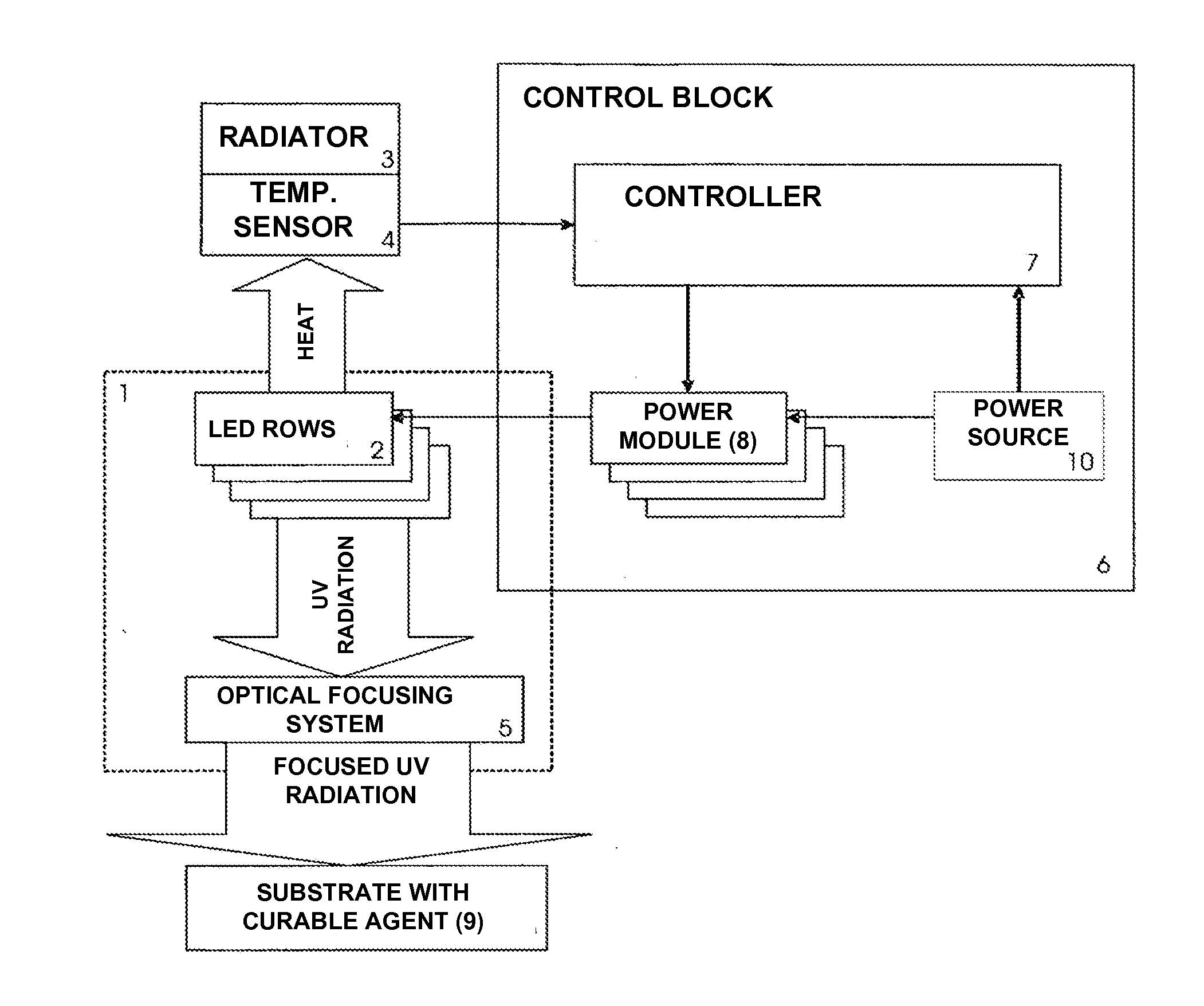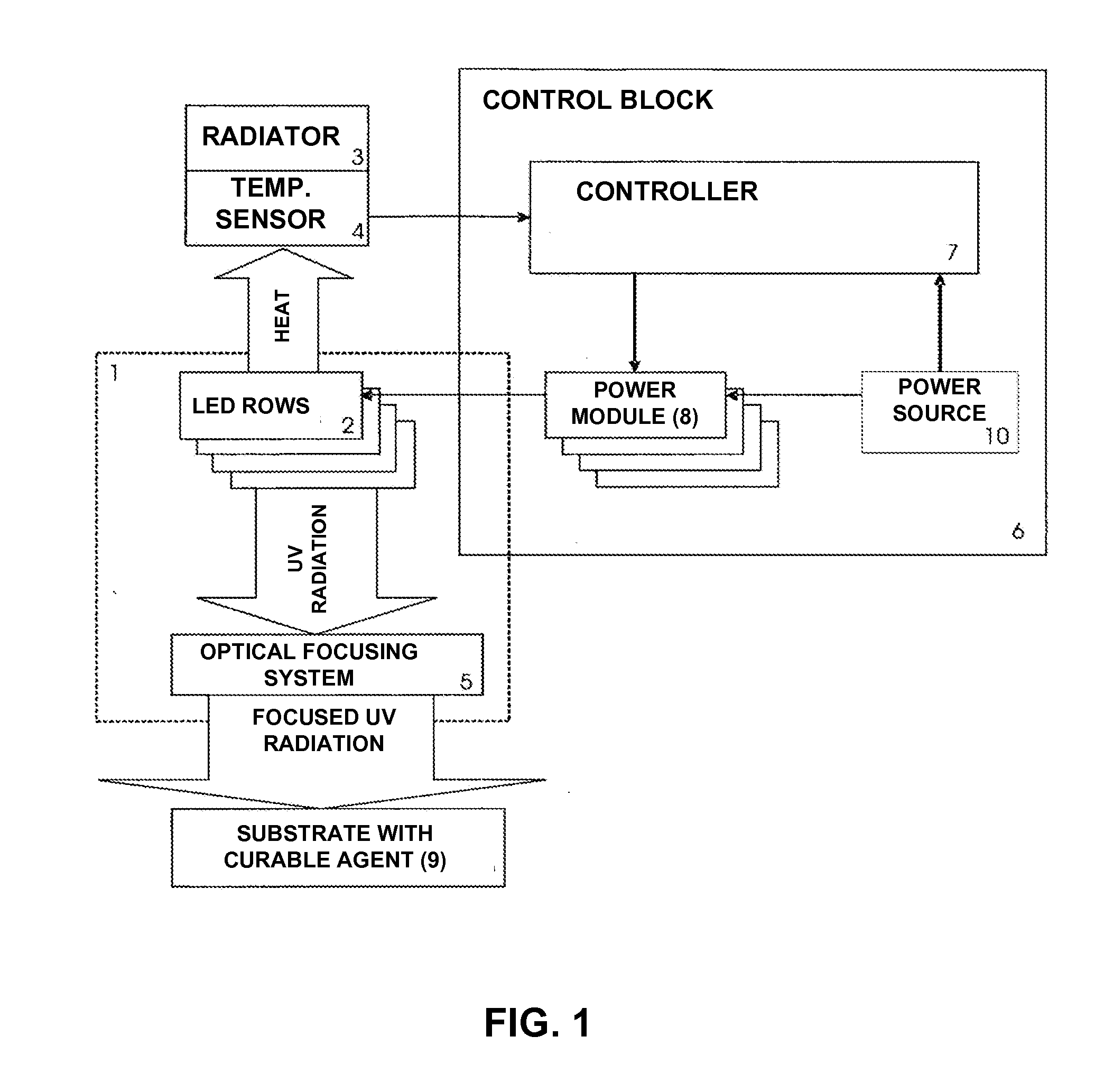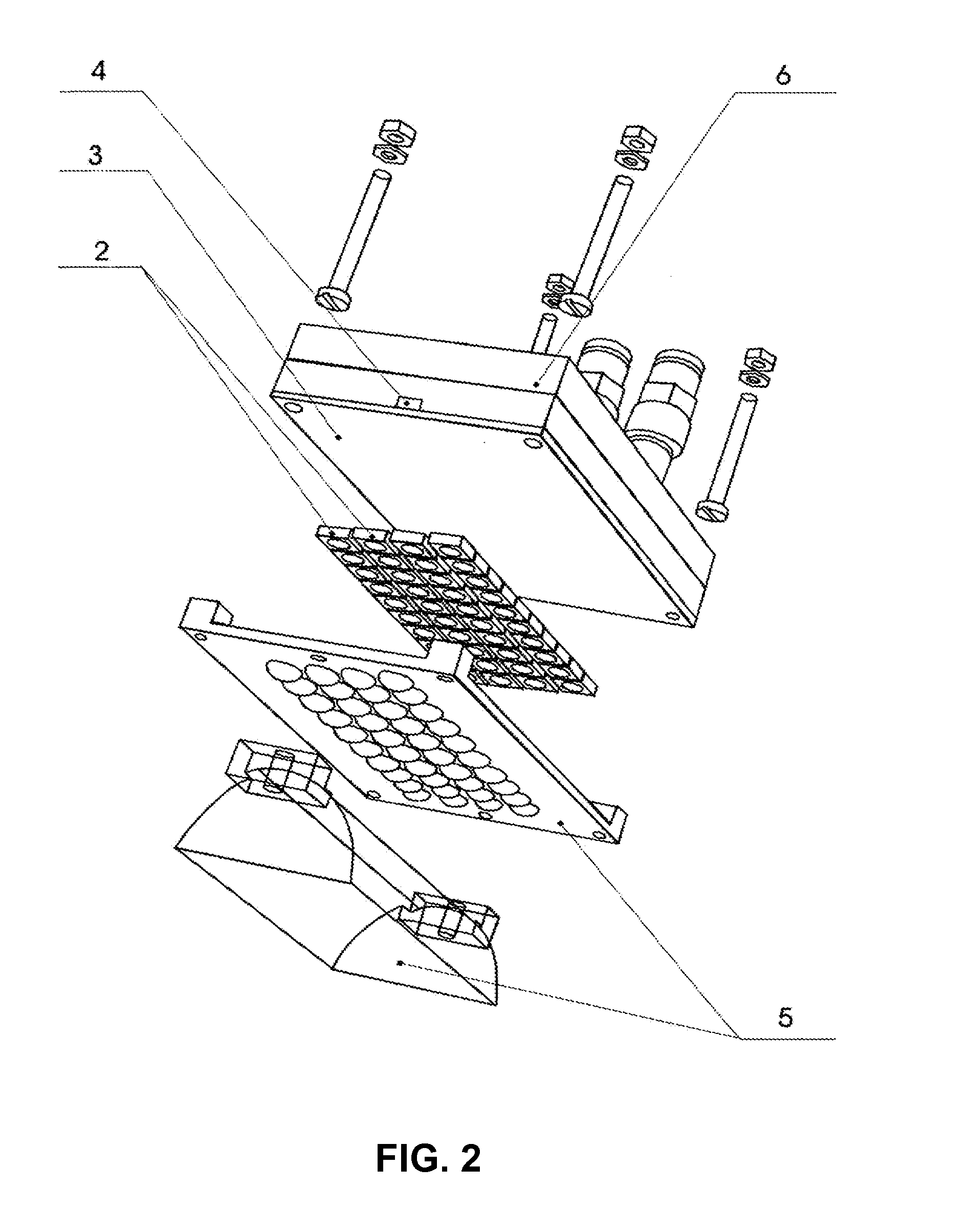Method for curing substances by UV radiation, device for carrying out said method and ink cured by UV radiation
a technology of uv radiation and curing method, which is applied in the direction of printing press, ink, printing, etc., can solve the problems of low efficiency factor, high operating temperature, and ink or paint on the substrate, and achieve the effect of avoiding fluorescent lamps, stable operating temperature, and high efficiency factor
- Summary
- Abstract
- Description
- Claims
- Application Information
AI Technical Summary
Benefits of technology
Problems solved by technology
Method used
Image
Examples
example 2
[0082]Preparation of UV Curable Black Ink.
[0083]The laboratory bead mill, with capacity of 1 liter, should be charged by: 1 kg of ceramic beads with the diameter of 0.6-0.8 mm; 75 g of black pigment—Carbon Black 7 (SB250 gas black, produced by Degussa); 350 g of modified difunctional acrylate (ViaJet 100 produced by CYTEC); 75 g of SN13 hyperdispersant and 75 g of SN10S (produced by TATI); 0.225 g of NPAL fotostabilizator (produced by WAKO Q1301), previously dissolved in 4.275 g dipropyleneglycoldiaacrylate.
[0084]Next, grinding and dispersion for 15 h to obtain the homogeneous mass with average particle size less than 0.5 microns comes. Then to the pigment paste should be added the following: 1520 g of modified difunctional acrylate (ViaJet 400 produced by CYTEC); 300 g of monofunctional acrylate (isoboronnileacrilate produced by CYTEC); 300 g of multifunctional acrylate (dipentaerythritolhexaacrylate, produced by Eternal). The mass should be filtered through 3-stage filter with 3-1...
example 3
[0087]Preparation of UV Curable Blue Ink.
[0088]The laboratory bead mill, with capacity of 1 liter, should be charged by: 1 kg of ceramic beads with the diameter of 0.6-0.8 mm; 30 g of blue pigment Phthalocyanine blue 15:3 (Hostapern Blue B2G-D, produced by Clariant); 350 g of modified difunctional acrylate (ViaJet 100. produced by CYTEC); per 3 g of the following hyperdispers ants: CH 13, CH 13B, CH11B, CH-10S (produced by TATI); 0.225 g of NPAL photostabilizator (produced by WAKO Q1301), previously dissolved in 4.275 g of dipropyleneglycoldiaacrylate. Next, grinding and dispersion for 15 h to obtain the homogeneous mass with average particle size less than 0.5 microns comes. Then to the pigment paste should be added: 1853 g of difunctional modified acrylate (ViaJet 400, produced by CYTEC); 300 g of monofunctional acrylate (isoboronnileacrilate, produced by CYTEC); 250 g of multifunctional acrylate (propoxylatepentaerythrinoltetraacrylaye), produced by Eternal. Then the mass should ...
example 4
[0090]Preparation of UV curable red ink. The laboratory bead mill, with capacity of 1 liter, should be charged by: 1 kg of ceramic beads with diameter of 0.6-0.8 mm; 30 g of red pigment, quinacridone red 122 (Hostapern Red E5B, produced by Clariant); 350 g of modified difunctional acrylate (ViaJet 100. produced by CYTEC); per 3 g of the following hyperdispersants: CH 13, CH 13B, CH11B, CH-10S (produced by TATI); 0.225 g NPAL photostabilizator (produced by WAKO Q1301), previously dissolved in 4.275 g of dipropyleneglycoldiaacrylate Next, both grinding and dispersion for 15 h to obtain the homogeneous mass with average particle size less than 0.5 microns. Then, to the pigment paste should be added: 1853 g of difunctional modified acrylate (ViaJet 400. produced by CYTEC); 350 g of monofunctional acrylate (isoboronnileacrilate, produced by CYTEC); 200 g of multifunctional acrylate (industrial monomer EM-6362 with 12-14 functional groups), produced by Eternal. Then the mass should be fil...
PUM
| Property | Measurement | Unit |
|---|---|---|
| wavelength | aaaaa | aaaaa |
| wavelengths | aaaaa | aaaaa |
| wavelengths | aaaaa | aaaaa |
Abstract
Description
Claims
Application Information
 Login to View More
Login to View More - R&D
- Intellectual Property
- Life Sciences
- Materials
- Tech Scout
- Unparalleled Data Quality
- Higher Quality Content
- 60% Fewer Hallucinations
Browse by: Latest US Patents, China's latest patents, Technical Efficacy Thesaurus, Application Domain, Technology Topic, Popular Technical Reports.
© 2025 PatSnap. All rights reserved.Legal|Privacy policy|Modern Slavery Act Transparency Statement|Sitemap|About US| Contact US: help@patsnap.com



